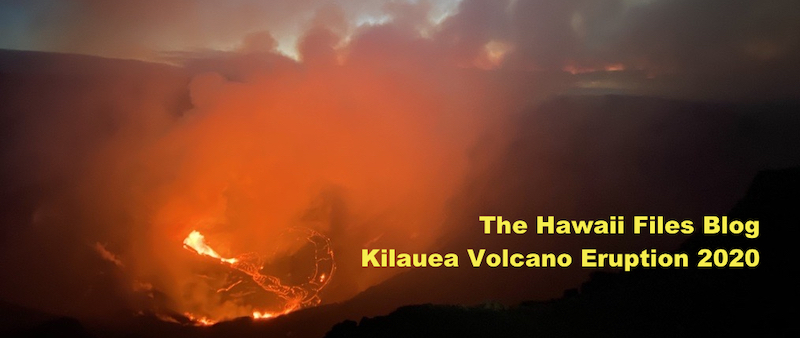Eruption Day 3: Vog is Building Up on Hawaii Island

VOG is Building Up on Hawaii Island
There is a lot of volcanic haze in the air at the Hawaii Volcanoes National Park and downwind to the Southwest of the Big Island impacting the communities in the Ka’u district and Ocean View Estates. Depending on the direction of the wind, the volcanic haze can and will probably blanket the entire island and eventually the whole state on some days. Individuals with medical conditions are urged to take preventative measures to deal with the vog such as limiting outdoor activities, staying indoors and securing your home from incoming vog vapors and using air conditioning systems in “recirculating” mode.
Below is the most recent press release from the USGS Hawaii Volcano observatories. Images appearing on this page are courtesy of the USGS and are in the public domain. Video clips are from their respective publishers.
HAWAIIAN VOLCANO OBSERVATORY DAILY UPDATE
U.S. Geological Survey
Wednesday, December 23, 2020, 8:53 AM HST (Wednesday, December 23, 2020, 18:53 UTC)
KILAUEA VOLCANO (VNUM #332010)
19°25’16” N 155°17’13” W, Summit Elevation 4091 ft (1247 m)
Current Volcano Alert Level: WATCH
Current Aviation Color Code: ORANGE
Activity Summary: No significant change. Kīlauea continues to erupt at its summit from two vents on the north and northwest sides of Halemaʻumaʻu. As of late yesterday afternoon, the growing crater lake was 143 m (470 ft) deep with a surface area of 22 ha (54 acres). SO2 emissions continue.
Summit Observations: Summit tiltmeters continued to record steady deflationary tilt. Sulfur dioxide emission rates remain high estimated at around 30,000 tonnes/day as measured on Monday (Dec. 21). Seismicity remained elevated but stable, with a few minor earthquakes and tremor fluctuations related to the vigor of fissure fountaining.
Halemaʻumaʻu lava lake observations: Of the three vents that erupted Sunday evening (Dec. 20) from the north and northwest walls of Halemaʻumaʻu, two remain active this morning. The west vent, which is located on the lowest down-dropped block within Halemaʻumaʻu crater, is feeding two narrow channels into the lake. The north vent remains the most vigorous.
The vents continued to feed lava into a rapidly enlarging lava lake filling Halemaʻumaʻu crater. As of yesterday afternoon, the lake surface was 143 m (470 ft) deep with an approximate lake volume of 12 million cubic meters (16 million cubic yards or 2.7 billion gallons). The surface area was about 22 ha (54 acres) and the lake shape was roughly oval with an east-west length of 690 m (750 yds) and a north-south width of 410 m (450 yds). A thermal map made from images obtained on an overflight yesterday just before noon can be viewed here: https://www.usgs.gov/maps/december-22-2020-k-lauea-summit-eruption-thermal-map.
An island of cooler, solidified lava within the lava lake has been getting smaller and drifting eastward in the lake yesterday through this morning. It appears to be about 150 m in diameter.
Webcam views of the lava lake can be found here: https://volcanoes.usgs.gov/volcanoes/kilauea/multimedia_webcams.html.
Hazard Analysis: High levels of volcanic gas, rockfalls, explosions, and volcanic glass particles are the primary hazards of concern regarding this new activity at Kīlauea’s summit. Large amounts of volcanic gas—primarily water vapor (H2O), carbon dioxide (CO2), and sulfur dioxide (SO2)—are continuously released during eruptions of Kīlauea Volcano. As SO2 is released from the summit during this new eruption, it will react in the atmosphere with oxygen, sunlight, moisture, and other gases and particles, and within hours to days, convert to fine particles. The particles scatter sunlight and cause the visible haze that has been observed downwind of Kīlauea, known as vog (volcanic smog), during previous summit eruptions. Vog creates the potential for airborne health hazards to residents and visitors, damages agricultural crops and other plants, and affects livestock operations. Rockfalls and minor explosions, such as the ones that occurred during the 2008–2018 lava lake eruption at Kīlauea summit, may occur suddenly and without warning. This underscores the extremely hazardous nature of Kīlauea caldera rim surrounding Halemaʻumaʻu crater, an area that has been closed to the public since late 2007. Pele’s hair and other lightweight volcanic glass fragments from the lava fountains within Halemaʻumaʻu will fall downwind of the fissure vents and lava lake, dusting the ground within a few hundred meters (yards) of the vent. High winds may waft lighter particles to greater distances. Residents are urged to minimize exposure to these volcanic particles, which can cause skin and eye irritation similar to volcanic ash.
Vog information can be found at https://vog.ivhhn.org/.
Please see this Hawaii Volcanoes National Park Press Release “How to Safely View the New Eruption in Hawaiʻi Volcanoes National Park” at https://www.nps.gov/havo/learn/news/20201221_nr_new-summit-eruption-kilauea.htm.
The Hawaiian Volcano Observatory (HVO) continues to closely monitor Kīlauea’s seismicity, deformation, and gas emissions for any sign of reactivation, and maintains visual surveillance of the summit and the East Rift Zone. HVO will continue to issue daily updates and additional messages as needed.
MORE INFORMATION:
Kilauea Activity summary also available by phone: (808) 967-8862
Other Hawaiian volcanoes summary also available by phone: (808) 967-8877
Big Island Video News 12-23-20
ApauHawaii Tours Early Morning VOG
